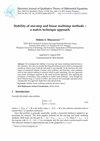F. Yao
求助PDF
{"title":"Weighted L p -type regularity estimates for nonlinear parabolic equations with Orlicz growth","authors":"F. Yao","doi":"10.14232/ejqtde.2022.1.17","DOIUrl":null,"url":null,"abstract":"<jats:p>In this paper we obtain the following weighted <mml:math xmlns:mml=\"http://www.w3.org/1998/Math/MathML\" xmlns=\"http://www.w3.org/1998/Math/MathML\"> <mml:msup> <mml:mi>L</mml:mi> <mml:mi>p</mml:mi> </mml:msup> </mml:math>-type regularity estimates <mml:math xmlns:mml=\"http://www.w3.org/1998/Math/MathML\" xmlns=\"http://www.w3.org/1998/Math/MathML\" display=\"block\"> <mml:mi>B</mml:mi> <mml:mrow> <mml:mo>(</mml:mo> <mml:mrow> <mml:mo>|</mml:mo> <mml:mrow class=\"MJX-TeXAtom-ORD\"> <mml:mi mathvariant=\"bold\">f</mml:mi> </mml:mrow> <mml:mo>|</mml:mo> </mml:mrow> <mml:mo>)</mml:mo> </mml:mrow> <mml:mo>∈<!-- ∈ --></mml:mo> <mml:msup> <mml:mi>L</mml:mi> <mml:mrow class=\"MJX-TeXAtom-ORD\"> <mml:mi>q</mml:mi> </mml:mrow> </mml:msup> <mml:mrow> <mml:mo>(</mml:mo> <mml:mrow> <mml:mi>ν<!-- ν --></mml:mi> <mml:mo>,</mml:mo> <mml:mi>ν<!-- ν --></mml:mi> <mml:mo>+</mml:mo> <mml:mi>T</mml:mi> <mml:mo>;</mml:mo> <mml:msubsup> <mml:mi>L</mml:mi> <mml:mi>w</mml:mi> <mml:mi>q</mml:mi> </mml:msubsup> <mml:mo stretchy=\"false\">(</mml:mo> <mml:mi mathvariant=\"normal\">Ω<!-- Ω --></mml:mi> <mml:mo stretchy=\"false\">)</mml:mo> </mml:mrow> <mml:mo>)</mml:mo> </mml:mrow> <mml:mtext> </mml:mtext> <mml:mstyle displaystyle=\"false\" scriptlevel=\"0\"> <mml:mtext>locally</mml:mtext> </mml:mstyle> <mml:mo stretchy=\"false\">⇒<!-- ⇒ --></mml:mo> <mml:mi>B</mml:mi> <mml:mrow> <mml:mo>(</mml:mo> <mml:mrow> <mml:mo>|</mml:mo> <mml:mrow> <mml:mi mathvariant=\"normal\">∇<!-- ∇ --></mml:mi> <mml:mi>u</mml:mi> </mml:mrow> <mml:mo>|</mml:mo> </mml:mrow> <mml:mo>)</mml:mo> </mml:mrow> <mml:mo>∈<!-- ∈ --></mml:mo> <mml:msup> <mml:mi>L</mml:mi> <mml:mrow class=\"MJX-TeXAtom-ORD\"> <mml:mi>q</mml:mi> </mml:mrow> </mml:msup> <mml:mrow> <mml:mo>(</mml:mo> <mml:mrow> <mml:mi>ν<!-- ν --></mml:mi> <mml:mo>,</mml:mo> <mml:mi>ν<!-- ν --></mml:mi> <mml:mo>+</mml:mo> <mml:mi>T</mml:mi> <mml:mo>;</mml:mo> <mml:msubsup> <mml:mi>L</mml:mi> <mml:mi>w</mml:mi> <mml:mi>q</mml:mi> </mml:msubsup> <mml:mo stretchy=\"false\">(</mml:mo> <mml:mi mathvariant=\"normal\">Ω<!-- Ω --></mml:mi> <mml:mo stretchy=\"false\">)</mml:mo> </mml:mrow> <mml:mo>)</mml:mo> </mml:mrow> <mml:mtext> </mml:mtext> <mml:mstyle displaystyle=\"false\" scriptlevel=\"0\"> <mml:mtext>locally</mml:mtext> </mml:mstyle> </mml:math> for any <mml:math xmlns:mml=\"http://www.w3.org/1998/Math/MathML\" xmlns=\"http://www.w3.org/1998/Math/MathML\"> <mml:mi>q</mml:mi> <mml:mo>></mml:mo> <mml:mn>1</mml:mn> </mml:math> of weak solutions for non-homogeneous nonlinear parabolic equations with Orlicz growth <mml:math xmlns:mml=\"http://www.w3.org/1998/Math/MathML\" xmlns=\"http://www.w3.org/1998/Math/MathML\" display=\"block\"> <mml:msub> <mml:mi>u</mml:mi> <mml:mi>t</mml:mi> </mml:msub> <mml:mo>−<!-- − --></mml:mo> <mml:mi>div</mml:mi> <mml:mo><!-- --></mml:mo> <mml:mrow> <mml:mo>(</mml:mo> <mml:mrow> <mml:mi>a</mml:mi> <mml:mrow> <mml:mo>(</mml:mo> <mml:msup> <mml:mrow> <mml:mo>(</mml:mo> <mml:mrow> <mml:mi>A</mml:mi> <mml:mi mathvariant=\"normal\">∇<!-- ∇ --></mml:mi> <mml:mi>u</mml:mi> <mml:mo>⋅<!-- ⋅ --></mml:mo> <mml:mi mathvariant=\"normal\">∇<!-- ∇ --></mml:mi> <mml:mi>u</mml:mi> </mml:mrow> <mml:mo>)</mml:mo> </mml:mrow> <mml:mrow class=\"MJX-TeXAtom-ORD\"> <mml:mfrac> <mml:mn>1</mml:mn> <mml:mn>2</mml:mn> </mml:mfrac> </mml:mrow> </mml:msup> <mml:mo>)</mml:mo> </mml:mrow> <mml:mi>A</mml:mi> <mml:mi mathvariant=\"normal\">∇<!-- ∇ --></mml:mi> <mml:mi>u</mml:mi> </mml:mrow> <mml:mo>)</mml:mo> </mml:mrow> <mml:mo>=</mml:mo> <mml:mi>div</mml:mi> <mml:mo><!-- --></mml:mo> <mml:mrow> <mml:mo>(</mml:mo> <mml:mrow> <mml:mi>a</mml:mi> <mml:mrow> <mml:mo>(</mml:mo> <mml:mrow> <mml:mo>|</mml:mo> <mml:mrow class=\"MJX-TeXAtom-ORD\"> <mml:mi mathvariant=\"bold\">f</mml:mi> </mml:mrow> <mml:mo>|</mml:mo> </mml:mrow> <mml:mo>)</mml:mo> </mml:mrow> <mml:mrow class=\"MJX-TeXAtom-ORD\"> <mml:mi mathvariant=\"bold\">f</mml:mi> </mml:mrow> </mml:mrow> <mml:mo>)</mml:mo> </mml:mrow> </mml:math> under some proper assumptions on the functions <mml:math xmlns:mml=\"http://www.w3.org/1998/Math/MathML\" xmlns=\"http://www.w3.org/1998/Math/MathML\"> <mml:mi>a</mml:mi> <mml:mo>,</mml:mo> <mml:mi>w</mml:mi> <mml:mo>,</mml:mo> <mml:mi>A</mml:mi> </mml:math> and <mml:math xmlns:mml=\"http://www.w3.org/1998/Math/MathML\" xmlns=\"http://www.w3.org/1998/Math/MathML\"> <mml:mrow class=\"MJX-TeXAtom-ORD\"> <mml:mi mathvariant=\"bold\">f</mml:mi> </mml:mrow> </mml:math>, where <mml:math xmlns:mml=\"http://www.w3.org/1998/Math/MathML\" xmlns=\"http://www.w3.org/1998/Math/MathML\"> <mml:mi>B</mml:mi> <mml:mo stretchy=\"false\">(</mml:mo> <mml:mi>t</mml:mi> <mml:mo stretchy=\"false\">)</mml:mo> <mml:mo>=</mml:mo> <mml:msubsup> <mml:mo>∫<!-- ∫ --></mml:mo> <mml:mn>0</mml:mn> <mml:mi>t</mml:mi> </mml:msubsup> <mml:mi>τ<!-- τ --></mml:mi> <mml:mi>a</mml:mi> <mml:mo stretchy=\"false\">(</mml:mo> <mml:mi>τ<!-- τ --></mml:mi> <mml:mo stretchy=\"false\">)</mml:mo> <mml:mspace width=\"thinmathspace\" /> <mml:mi>d</mml:mi> <mml:mi>τ<!-- τ --></mml:mi> </mml:math>. Moreover, we remark that two natural examples of functions <mml:math xmlns:mml=\"http://www.w3.org/1998/Math/MathML\" xmlns=\"http://www.w3.org/1998/Math/MathML\"> <mml:mi>a</mml:mi> <mml:mo stretchy=\"false\">(</mml:mo> <mml:mi>t</mml:mi> <mml:mo stretchy=\"false\">)</mml:mo> </mml:math> are <mml:math xmlns:mml=\"http://www.w3.org/1998/Math/MathML\" xmlns=\"http://www.w3.org/1998/Math/MathML\" display=\"block\"> <mml:mi>a</mml:mi> <mml:mo stretchy=\"false\">(</mml:mo> <mml:mi>t</mml:mi> <mml:mo stretchy=\"false\">)</mml:mo> <mml:mo>=</mml:mo> <mml:msup> <mml:mi>t</mml:mi> <mml:mrow class=\"MJX-TeXAtom-ORD\"> <mml:mi>p</mml:mi> <mml:mo>−<!-- − --></mml:mo> <mml:mn>2</mml:mn> </mml:mrow> </mml:msup> <mml:mspace width=\"1em\" /> <mml:mstyle displaystyle=\"false\" scriptlevel=\"0\"> <mml:mtext>(</mml:mtext> <mml:mrow class=\"MJX-TeXAtom-ORD\"> <mml:mi>p</mml:mi> </mml:mrow> <mml:mtext>-Laplace equation)</mml:mtext> </mml:mstyle> <mml:mspace width=\"1em\" /> <mml:mstyle displaystyle=\"false\" scriptlevel=\"0\"> <mml:mtext>and</mml:mtext> </mml:mstyle> <mml:mspace width=\"1em\" /> <mml:mi>a</mml:mi> <mml:mo stretchy=\"false\">(</mml:mo> <mml:mi>t</mml:mi> <mml:mo stretchy=\"false\">)</mml:mo> <mml:mo>=</mml:mo> <mml:msup> <mml:mi>t</mml:mi> <mml:mrow class=\"MJX-TeXAtom-ORD\"> <mml:mi>p</mml:mi> <mml:mo>−<!-- − --></mml:mo> <mml:mn>2</mml:mn> </mml:mrow> </mml:msup> <mml:msup> <mml:mi>log</mml:mi> <mml:mi>α<!-- α --></mml:mi> </mml:msup> <mml:mo><!-- --></mml:mo> <mml:mrow class=\"MJX-TeXAtom-ORD\"> <mml:mo maxsize=\"1.2em\" minsize=\"1.2em\">(</mml:mo> </mml:mrow> <mml:mn>1</mml:mn> <mml:mo>+</mml:mo> <mml:mi>t</mml:mi> <mml:mrow class=\"MJX-TeXAtom-ORD\"> <mml:mo maxsize=\"1.2em\" minsize=\"1.2em\">)</mml:mo> </mml:mrow> <mml:mspace width=\"1em\" /> <mml:mstyle displaystyle=\"false\" scriptlevel=\"0\"> <mml:mtext>for</mml:mtext> </mml:mstyle> <mml:mtext> </mml:mtext> <mml:mi>α<!-- α --></mml:mi> <mml:mo>></mml:mo> <mml:mn>0.</mml:mn> </mml:math> Moreover, our results improve the known results for such equations.</jats:p>","PeriodicalId":50537,"journal":{"name":"Electronic Journal of Qualitative Theory of Differential Equations","volume":"1 1","pages":""},"PeriodicalIF":0.8000,"publicationDate":"2022-01-01","publicationTypes":"Journal Article","fieldsOfStudy":null,"isOpenAccess":false,"openAccessPdf":"","citationCount":"0","resultStr":null,"platform":"Semanticscholar","paperid":null,"PeriodicalName":"Electronic Journal of Qualitative Theory of Differential Equations","FirstCategoryId":"100","ListUrlMain":"https://doi.org/10.14232/ejqtde.2022.1.17","RegionNum":4,"RegionCategory":"数学","ArticlePicture":[],"TitleCN":null,"AbstractTextCN":null,"PMCID":null,"EPubDate":"","PubModel":"","JCR":"Q1","JCRName":"MATHEMATICS","Score":null,"Total":0}
引用次数: 0
引用
批量引用
具有Orlicz增长的非线性抛物方程的加权L p型正则性估计
本文得到了以下加权L p型正则性估计B (| f |)∈L q (ν, ν + T;L w q (Ω))局部⇒B(|∇u |)∈L q (ν, ν + T;L w q (Ω))局部求解具有Orlicz增长的非齐次非线性抛物方程弱解的任意q > 1) A∇u) = div (A (| f |) f),在函数A, w, A和f的适当假设下,其中B (t) =∫0 t τ A (τ) d τ。此外,我们注意到函数a (t)的两个自然例子是a (t) = t p−2 (p -拉普拉斯方程)和a (t) = t p−2 log α > 0。此外,我们的结果改进了已知的此类方程的结果。
本文章由计算机程序翻译,如有差异,请以英文原文为准。

 求助内容:
求助内容: 应助结果提醒方式:
应助结果提醒方式:


